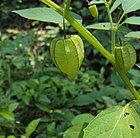Note: This is a project under development. The articles on this wiki are just being initiated and broadly incomplete. You can Help creating new pages.
Difference between revisions of "Physalis minima"
| Line 2: | Line 2: | ||
'''Physalis minima''' is a species of perennial herbs elonging to the family Solanaceae. It is a pantropical annual herb 20–50 cm high at its maturity. It can be found near the marshes of Java. | '''Physalis minima''' is a species of perennial herbs elonging to the family Solanaceae. It is a pantropical annual herb 20–50 cm high at its maturity. It can be found near the marshes of Java. | ||
==Uses== | ==Uses== | ||
| − | {{Uses|Relieve pain}}. | + | {{Uses|Relieve pain}}, {{Uses|Urinary problems}}, {{Uses|Skin diseases}}. |
==Parts Used== | ==Parts Used== | ||
| Line 38: | Line 38: | ||
===Flower=== | ===Flower=== | ||
{{Flower|Bisexual||Greenish yellow sometimes brownish yellow||The flowers have 5 Regular Parts and are up to 2cm wide.}} | {{Flower|Bisexual||Greenish yellow sometimes brownish yellow||The flowers have 5 Regular Parts and are up to 2cm wide.}} | ||
| − | |||
| − | |||
===Other features=== | ===Other features=== | ||
| Line 67: | Line 65: | ||
<ref name="chemical composition">[https://www.ncbi.nlm.nih.gov/pmc/articles/PMC3224402/#:~:text=Physalis%20minima%20is%20an%20important%20medicinal%20plant%20of%20Indian%20System%20of%20Medicine.&text=The%20major%20chemical%20constituents%20reported,be%20a%20potent%20antiinfective%20agent. Chemical composition]</ref> | <ref name="chemical composition">[https://www.ncbi.nlm.nih.gov/pmc/articles/PMC3224402/#:~:text=Physalis%20minima%20is%20an%20important%20medicinal%20plant%20of%20Indian%20System%20of%20Medicine.&text=The%20major%20chemical%20constituents%20reported,be%20a%20potent%20antiinfective%20agent. Chemical composition]</ref> | ||
| − | <ref name="Leaf"> | + | <ref name="Leaf">Kappatagudda - A Repertoire of Medicianal Plants of Gadag by Yashpal Kshirasagar and Sonal Vrishni, Page No. 308</ref> |
<ref name="How to plant/cultivate">[https://hort.purdue.edu/newcrop/parmar/16.html#:~:text=Physalis%20minima%20Linn.%20is%20commonly,to%20altitudes%20of%201%2C650%20metres. Cultivation Details]</ref> | <ref name="How to plant/cultivate">[https://hort.purdue.edu/newcrop/parmar/16.html#:~:text=Physalis%20minima%20Linn.%20is%20commonly,to%20altitudes%20of%201%2C650%20metres. Cultivation Details]</ref> | ||
Revision as of 17:35, 13 May 2021
Physalis minima is a species of perennial herbs elonging to the family Solanaceae. It is a pantropical annual herb 20–50 cm high at its maturity. It can be found near the marshes of Java.
Contents
- 1 Uses
- 2 Parts Used
- 3 Chemical Composition
- 4 Common names
- 5 Properties
- 6 Habit
- 7 Identification
- 8 List of Ayurvedic medicine in which the herb is used
- 9 Where to get the saplings
- 10 Mode of Propagation
- 11 How to plant/cultivate
- 12 Commonly seen growing in areas
- 13 Photo Gallery
- 14 References
- 15 External Links
Uses
Relieve pain, Urinary problems, Skin diseases.
Parts Used
Chemical Composition
The plant have phenolics and alkaloids.[1]
Common names
| Language | Common name |
|---|---|
| Kannada | Gadde hannu |
| Hindi | Rasbhari, Ban Tipariya |
| Malayalam | Kupanti |
| Tamil | Notinotta |
| Telugu | Kupanti |
| Marathi | NA |
| Gujarathi | NA |
| Punjabi | NA |
| Kashmiri | NA |
| Sanskrit | |
| English | Ground Cherry, Sun berry |
Properties
Reference: Dravya - Substance, Rasa - Taste, Guna - Qualities, Veerya - Potency, Vipaka - Post-digesion effect, Karma - Pharmacological activity, Prabhava - Therepeutics.
Dravya
Rasa
Guna
Veerya
Vipaka
Karma
Prabhava
Habit
Identification
Leaf
| Kind | Shape | Feature |
|---|---|---|
| Simple | Round in outline | Leaves can reach 10cm in length. Each leaf is toothed or lobed |
Flower
| Type | Size | Color and composition | Stamen | More information |
|---|---|---|---|---|
| Bisexual | Greenish yellow sometimes brownish yellow | The flowers have 5 Regular Parts and are up to 2cm wide. |
Other features
List of Ayurvedic medicine in which the herb is used
Where to get the saplings
Mode of Propagation
How to plant/cultivate
Physalis minima Linn. is commonly found on the bunds of the fields, wastelands, around the houses, on roadsides, etc.[3]
Commonly seen growing in areas
Photo Gallery
References
- ↑ Chemical composition
- ↑ Kappatagudda - A Repertoire of Medicianal Plants of Gadag by Yashpal Kshirasagar and Sonal Vrishni, Page No. 308
- ↑ Cultivation Details
External Links
Categories:
- Ayurvedic Herbs known to be helpful to treat Relieve pain
- Ayurvedic Herbs known to be helpful to treat Urinary problems
- Ayurvedic Herbs known to be helpful to treat Skin diseases
- Herbs with Fruits used in medicine
- Herbs with Leaves used in medicine
- Herbs with common name in Kannada
- Herbs with common name in Hindi
- Herbs with common name in Malayalam
- Herbs with common name in Tamil
- Herbs with common name in Telugu
- Herbs with common name in English
- Habit - Herbs
- Index of Plants which can be propagated by Seeds
- Herbs that are commonly seen in the region of Lowland forest
- Herbs
- Solanaceae



